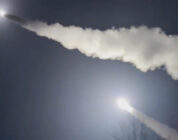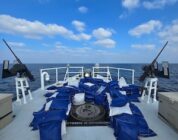NAVAL AIR WEAPONS STATION CHINA LAKE, California — The “Dust Devils” of the Navy’s Air Test and Evaluation Squadron (VX-31) brought the AV-8B Harrier’s decades-long testing era to an official close this fall with one final sortie flown by the squadron’s last remaining Harrier pilot, Technical Director James “Jimbo” Coppersmith.
Warm desert winds drifted gently from the southwest as Coppersmith prepared for a moment steeped in aviation history. For the pilot, it also signified the conclusion of a distinguished 29-year career flying the jump jet.
The Harrier’s Rolls-Royce Pegasus engine whined loudly, its unique high pitch filling the Mojave Desert air. Coppersmith eased the throttle up to full military power and released the brakes, feeling the familiar surge pin him against the seat as the jet accelerated rapidly down the runway. At only 850 feet down the strip, he rotated the Harrier’s four nozzles, quickly launching into the air.
It was a perfect day for flying — and a fitting desert backdrop for a milestone that marked the close of a storied chapter in modern military aviation. For nearly four decades, VX-31 has pushed the envelope of the Harrier’s potential, refining its capabilities to deliver unmatched vertical-lift capability to Marine Corps aviation.
Using the callsign “Last 1,” Coppersmith climbed out into the sky at 300 knots as the sound of the jet’s engine faded quickly into the distance.
The AV-8 Harrier is a small, short-wing, light attack brawler that was bred for one gritty purpose: close air support. It was a crazy idea that broke all conventions: a jet that didn’t need long runways, could claw off short strips, even hover like a helicopter — so the Marines grabbed a very British oddball, hacked and hardened it, then launched it off forward operating bases and stubby decks of amphibious ships, becoming a cornerstone of Marine Corps aviation for ground-attack.

The “Dust Devils” at Naval Air Weapons Station China Lake have been the operational backbone of the AV-8B Harrier series’ evolution, pushing vertical or short takeoff and landing, or V/STOL, innovation and providing support to the fleet and allied forces with new weapons, sensors, pods and procedures. From the original day attack to the night attack and finally to radar with the AV-8B II, the squadron played a pivotal role.
VX-31 Commanding Officer Lt. Col. Timothy Burchett described the Harrier as one of the most challenging and rewarding aircraft to fly.
“This is a pilot’s airplane,” Burchett said. “There are no computers. It’s cables, pulleys and the skill required to keep that thing in the air.”
By pairing test pilots with software writers, systems engineers and weapons experts, VX-31 turned a notoriously demanding V/STOL jet into a safer, more lethal and more reliable combat asset while pushing the Harrier to its limits.
They tested everything from flight-control logic to laser targeting pods and night vision goggles, full Link 16 integration for the modern battlefield, precision weapons, survivability systems and biofuels — breaking what needed breaking, fixing what needed fixing and rebuilding it better.
“Over the years, we’ve continued to add more things, more capabilities,” Flight Test Engineer Tom Crouse observed. “It’s been a non-stop churn of upgrading the Harrier’s system. It’s one of the last true low-level CAS mission aircraft.”
Flight Test Director Harvey Pierce noted, “The biggest evolution for us was going from analog to digital with the [Open Systems Core Avionics Requirements/Standards] program, so we upgraded the system to get some of the newer weapons. We just kept putting more stuff into the airplane.”
From weapons separation to flight-control logic, they tested the jet until it could be trusted at the edge — and then pushed it further. VX-31’s hands-on, code-to-cockpit approach has kept the AV-8B Harrier relevant long after its 1985 debut, embodying disciplined experimentation and inventive engineering.
The final flight drew veterans, sailors, Marines, government civilians, industry partners and family members to the squadron’s flightline.

After departing the airfield, Coppersmith took one last lap around the high desert he knew so well, tracing familiar landmarks outside the China Lake boundaries before returning to base an hour later.
Crossing back over the airfield for his final break in front of the guests, he set up his Harrier for one last performance — demonstrating the plane’s defining V/STOL capabilities.
As the jet began to slow down, Coppersmith extended the Harrier’s outrigger landing gear and rotated the Harrier’s nozzles downward.
The heat distorted the air as the jet steadied itself into a slow hover, then slowly descended to the ground, landing for a moment, then lifted off the runway straight up in a vertical climb.
Aligning with the spectators watching in front of the squadron’s hangar, Coppersmith then dipped the Harrier’s nose slightly and worked the nozzle levers in a brief bow to the crowd. It was a small flourish, but an unmistakable farewell.
Two fire engines waiting for Coppersmith’s return gave a traditional water salute as he passed through, marking the end of his final flight.
Harrier 88’s engine was shut down for the last time directly in front of VX-31’s hangar as Coppersmith climbed out from the cockpit to applause and salutes as he greeted the crowd.
In the squadron’s Hangar 6, a massive flag was draped behind the podium, with the audience seated directly in front. The Dust Devils’ other last remaining Harrier, 82, sat to the side on full display in the corner.
Speaking to the audience, Lt. Col. Burchett commended the China Lake team for safely guiding the program to its conclusion.
“We did not coast into the finish line,” he told the crowd. “It was a triumphant finish. … The Harrier team was true innovators in what we call integrated test, helping to get capabilities into the frontline warfighter’s hands faster.”
Coppersmith then reflected on the aircraft’s Marine Corps aviation legacy.
“To put today in context, the Marine Corps has been in the V/STOL attack business for 54 years,” he said. “We shut it down full mission capable. It’s a testament to what we’ve done to this aircraft as a team.
“It’s the most successful attack aircraft in Marine Corps history,” Coppersmith continued, underscoring the Harrier’s enduring significance to the Marine Corps mission. “No doubt about it. We lost a lot of great Marines along the way, and we honored each of these with every procedure and material solution that improved the safety and reliability of this aircraft.”
Speaking about the Harrier’s legacy, Naval Test Wing Pacific Commodore Capt. David Halpern noted, “The Jump Jet proved that ‘runways optional’ wasn’t a punch line — it was a revolution. The U.S. Marine Corps took that revolution and made it a doctrine. It was a promise to the rifleman: close air support would be there, even when infrastructure wasn’t. And here at China Lake, the Dust Devils wrote vital pages of that story.”
“[These] teams tested, pushed, broke, fixed and made the Harrier — and vertical lift aviation — better, safer, deadlier and more reliable for the fleet,” Halpern added. “That is not routine work — that is heritage.”




